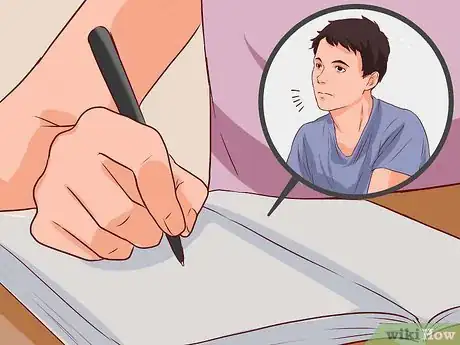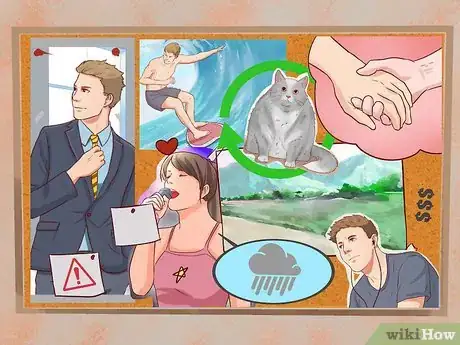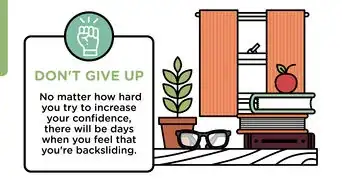This article was co-authored by Rahti Gorfien, PCC. Rahti Gorfien is a Life Coach and the Founder of Creative Calling Coaching, LLC. She specializes in working with artists, entrepreneurs, and college students in creative fields. Rahti is accredited as a Professional Certified Coach (PCC) by the International Coach Federation, an ACCG Accredited ADHD Coach by the ADD Coach Academy, and a Career Specialty Services Provider (CSS). In addition, she has personal experience in the fields she coaches - she is an alumnus of the New York University Graduate Acting program and has been a working theater artist for over 30 years. She was voted one of the 15 Best Life Coaches in New York City by Expertise in 2018.
There are 21 references cited in this article, which can be found at the bottom of the page.
wikiHow marks an article as reader-approved once it receives enough positive feedback. This article received 13 testimonials and 85% of readers who voted found it helpful, earning it our reader-approved status.
This article has been viewed 562,575 times.
Learning how to express yourself in a healthy way can be a wonderful way to live an authentic, more fulfilling life. Practicing expressing yourself and being true to who you are is essential to becoming strong in believing in yourself, releasing emotions, and creating the life that you want.[1]
Steps
Laying the Groundwork
-
1Listen to yourself. Self expression, which is the ability to communicate and demonstrate your feelings honestly, is an important factor in embarking on the journey of finding out who you really are. You can start finding who you are by listening to yourself, how you feel, and how you want to react to a situation. This can get you more in tune with your feelings and emotions, helping you begin to express yourself.[2]
-
2Acknowledge your emotions. Emotions can be challenging and it can be hard for anyone to learn how to listen to and honor these feelings. You may also not know how to safely express your emotions.[3] You may not have had a lot of experience in really tuning into to how you feel. It is common to stuff emotions away, to feel embarrassed or ashamed of emotions you may have, or hide your emotions completely.[4]
- For example, your friend forgets that you are supposed to hang out and doesn't show up or call you. It is okay to feel angry and upset about this situation. Acknowledge that your emotions of anger and sadness are valid and understandable. Do not belittle your feelings, even if she apologizes. You had a right to feel them and legitimize them.
- Getting closer to your emotions will get you more in touch with who you really are. The closer you feel to your authentic self, the less anxiety, depression, and overall dissatisfaction you may feel in your life in general.[5]
Advertisement -
3Focus on how your body reacts. This may be a new experience for you. One of the best ways to tune into how you feel is being aware of your body. One easy way to test this out is notice how your body responds to an emotional situation. You can start with something very easy, such as anger expressed through road rage. Whether you ride the bus or drive a car, you have probably become frustrated or angry with traffic and can identify this feeling of anger.
- Notice what parts of your body become tense, what happens to your breathing, and what happens in your abdomen or stomach.
Writing Down How You Feel
-
1Start a feelings journal. Start keeping track of your emotions in feelings journal, which can be a small notebook or on your mobile device. Try this next time you are watching a tearjerker movie to keep track of sadness. Write down how you physically respond to sadness. Is it difficult for you to cry? What does your chest feel like when you feel sad?[6]
- Try to stay out of your thoughts as your create your feelings journal and stay focused on your body's response. This will help you start to become more connected to how you really feel instead of just brushing emotions aside.[7]
-
2Own your emotions. You may be in the habit of telling yourself that you’re just being silly for feeling a certain way. You may also tell yourself not to feel a certain way. As you become more accustomed to recognizing your body’s response to emotions, it will be more difficult to just shrug off emotions. Your body is responding for a reason, and it is important to validate that. Get out your journal and start keeping a log of all the different feelings you had that day.[8]
- For example, write things like, "Today at work my boss made me really angry." Validate that anger and write about why you were angry. Do this for all the emotions you feel each day. You may be surprised at the rich emotional landscape you actually have inside of you once you start paying attention.
- Humans are naturally emotional beings, and it is easy in a fast-paced world to become disconnected from how you really feel.[9]
-
3Write down how you want to express yourself. To better express yourself emotionally every day, write down how you want to handle each situation. Then you can do practice runs of how you would like to act in certain situations. Using a boss or authority figure as an example again, start writing out exactly what you would like to say to then. Don't edit yourself and make it as raw and as graphic as you like.[10]
- If you saw something that day that made you sad, such as someone in distress or a lost animal, write out your uncensored sadness in your journal. Also continue to notice how your body physically responds.[11]
Expressing Yourself Verbally
-
1Express yourself safely. You need to figure out how to translate your emotions from their raw, unedited state into something productive that won't hurt others. Part of learning how to express your emotions is learning how to express them safely without hurting yourself or others. Use your journal to reframe your angry thoughts into sentences that express and validate how you feel, but won’t get you fired or in trouble.[12]
- For example, instead of screaming at someone and telling them you hate them, use your journal to write down different ways of expressing this that won’t have negative consequences on your life. Write phrases in your journal such as, "When my boss does this, I feel angry." or "When my parents yell at me, I feel angry." You are giving yourself the power to feel your emotions without letting your emotions have power over you.
- This works for other emotions as well.[13]
-
2Put your plans into action. It is important to become comfortable with your emotions as not a black and white type of scenario. This will allow you to let your emotions to guide you in knowing when it is time to speak up, or when it is appropriate to express your emotions privately and move on.
- For example, employers can be very frustrating. However, you have to ask yourself in any given situation what the benefit will be to you. Will your boss hear you? Will your boss understand? Would it be healthier to express your anger at home, writing about it in your journal than to engage in confrontation? You want to make sure you are true to your emotions and act on the right form of expression.[14]
- Most people haven’t been shown healthy examples of how to express emotions, and these basic emotional tools have been absent from our lives. Expressing emotions is an essential part of living an emotionally healthy life, setting boundaries in you relationships, feeling validated and getting your emotional needs met.[15]
-
3Use "I" phrases. Always use “I” statements when expressing your feelings to others. Say things like, “When you told me what happened, I felt very sad for you and what you are going through”. This can be used in relationships as well. For example, say “When you get frustrated with me for making mistakes, I feel ashamed.” or “When you say negative things about me, I feel angry.”[16]
- This way, you are taking full responsibility for yourself, your emotions, and expressing how you feel.[17]
-
4Practice. Learning to navigate the complex array of emotions that you feel can be daunting, and it will take practice. If you are not used to expressing your emotions, you can look at this exercise almost like emotional weight training. At first, your emotional muscles may be sore, weak, and not used to being so rigorously used and paid attention to.
- Exploring your authentic self and learning to express yourself is not easy. However, living an authentic life and feeling as though you are honoring yourself as well as validating your emotions will result in a richer, deeper, and more humanly authentic life experience.[18]
Expressing Yourself Creatively
-
1Try painting, drawing or sketching. Find ways to express yourself creatively that makes you happy. Try to paint, draw, or sketch if this is something you enjoy. Acrylic paints are inexpensive and can be used on just about any surface. Tune into colors and what emotions you feel they express.[19]
- Get a sketch book that is unlined and try drawing or sketching, tuning in to how you feel inside. Many art schools and museums offer free drawing sessions if you want to start off in a more structured environment.
- Allow your inner self and inner emotions to guide you as you create. Taking time to sit and paint or draw can also be relaxing. Don’t judge your abilities. Expressing yourself creatively is not about becoming the next Leonardo da Vinci, it’s about the act of creating. Learning to express yourself means learning to get to know yourself. Unleashing the creative side of yourself can be a surprising and fulfilling way to get a handle on who you really are inside.[20]
-
2Start collaging. Collaging is a fun craft that will allow you to express yourself. All you need are some old magazines or anything with images printed on it, some cardboard, and a glue stick. Find pictures that resonate with how you feel and what you want to express. Use words and headlines to accentuate the visual images.[21]
- Don’t limit yourself to just cardboard. Collage the cover of your emotion journal or sketchbook. Decorate an old box, a folder, or anything you might have laying around that you want to express yourself on. Express how you feel politically, spiritually, globally, or make it personal to your life. [22]
-
3Dance. Sometimes, expressing yourself with physical movement can help free up your inner feelings and desires. Get comfortable in your own skin by moving around and dancing. Dance in the privacy of your own home, or go out to a dance club. Listen to music that fits your mood and that you enjoy.[23]
- If you are angry, put on some music that reflects that anger and let your body move. Do the same thing is you feel happy, sad, or afraid. Try dancing to music that will help change your mood, such as dance to music that makes you feel empowered if you are afraid or to happy music if you are sad.
- Also try classes if you want to dance in a more structured environment. There are dance studios that offer programs for beginners that don’t require a huge time commitment. Take a beginner class in hip hop, jazz, or ballet class, as long as it fits you and your personality best.[24]
-
4Write creatively. A great way to express yourself is through writing. Write poetry or short stories using imagery based on your authentic feelings and life. Focus on how you feel and just write. Let go of any expectations of perfection or even showing your writing to anyone else. Expressing yourself creatively is about you and taking the time to learn about who you are and the intricate person inside you.
- Freeing yourself by writing can be extraordinarily illuminating and give you rich insights into thoughts and feelings you may not even be aware you had inside you.[25]
-
5Sing. Singing is a great activity, even if you are not great at it. You can sing anywhere, such as in your car, in the shower, or in your living room. Leave any expectations of perceived talent or vocal mastery out of your mind and let your voice be heard. Tune in to that emotional place and sing songs that resonate with you.[26]
- Sing songs that honor your feelings, such as sadness, loss, anger, love, and happiness. Allow yourself to be yourself through song.
- If singing is something that really makes you feel like you, you can take it out in the real world as well. Try karaoke or join a community singing group. Connect with music that makes you feel like you are expressing your life, your feelings, and yourself.[27]
Expert Q&A
Did you know you can get expert answers for this article?
Unlock expert answers by supporting wikiHow
-
QuestionHow can I express myself better?
 Rahti Gorfien, PCCRahti Gorfien is a Life Coach and the Founder of Creative Calling Coaching, LLC. She specializes in working with artists, entrepreneurs, and college students in creative fields. Rahti is accredited as a Professional Certified Coach (PCC) by the International Coach Federation, an ACCG Accredited ADHD Coach by the ADD Coach Academy, and a Career Specialty Services Provider (CSS). In addition, she has personal experience in the fields she coaches - she is an alumnus of the New York University Graduate Acting program and has been a working theater artist for over 30 years. She was voted one of the 15 Best Life Coaches in New York City by Expertise in 2018.
Rahti Gorfien, PCCRahti Gorfien is a Life Coach and the Founder of Creative Calling Coaching, LLC. She specializes in working with artists, entrepreneurs, and college students in creative fields. Rahti is accredited as a Professional Certified Coach (PCC) by the International Coach Federation, an ACCG Accredited ADHD Coach by the ADD Coach Academy, and a Career Specialty Services Provider (CSS). In addition, she has personal experience in the fields she coaches - she is an alumnus of the New York University Graduate Acting program and has been a working theater artist for over 30 years. She was voted one of the 15 Best Life Coaches in New York City by Expertise in 2018.
Life Coach Create something that doesn't exist. Focus your attention and resourcefulness on your creative side to bring something new to the world. If you find something meaningful that doesn't exist, find a way to bring it to life like drawing a new cartoon character you made up or writing the book you've always wanted to read.
Create something that doesn't exist. Focus your attention and resourcefulness on your creative side to bring something new to the world. If you find something meaningful that doesn't exist, find a way to bring it to life like drawing a new cartoon character you made up or writing the book you've always wanted to read. -
QuestionHow you can express your creativity?
 Rahti Gorfien, PCCRahti Gorfien is a Life Coach and the Founder of Creative Calling Coaching, LLC. She specializes in working with artists, entrepreneurs, and college students in creative fields. Rahti is accredited as a Professional Certified Coach (PCC) by the International Coach Federation, an ACCG Accredited ADHD Coach by the ADD Coach Academy, and a Career Specialty Services Provider (CSS). In addition, she has personal experience in the fields she coaches - she is an alumnus of the New York University Graduate Acting program and has been a working theater artist for over 30 years. She was voted one of the 15 Best Life Coaches in New York City by Expertise in 2018.
Rahti Gorfien, PCCRahti Gorfien is a Life Coach and the Founder of Creative Calling Coaching, LLC. She specializes in working with artists, entrepreneurs, and college students in creative fields. Rahti is accredited as a Professional Certified Coach (PCC) by the International Coach Federation, an ACCG Accredited ADHD Coach by the ADD Coach Academy, and a Career Specialty Services Provider (CSS). In addition, she has personal experience in the fields she coaches - she is an alumnus of the New York University Graduate Acting program and has been a working theater artist for over 30 years. She was voted one of the 15 Best Life Coaches in New York City by Expertise in 2018.
Life Coach Create something that doesn't exist. Focus your attention and resourcefulness on your creative side to bring something new to the world. If you find something meaningful that doesn't exist, find a way to bring it to life like drawing a new cartoon character you made up or writing the book you've always wanted to read.
Create something that doesn't exist. Focus your attention and resourcefulness on your creative side to bring something new to the world. If you find something meaningful that doesn't exist, find a way to bring it to life like drawing a new cartoon character you made up or writing the book you've always wanted to read. -
QuestionWhy do we have to express ourselves?
 Community AnswerIt helps us from holding emotions in for too long. Instead of boxing in the emotions or acting out the emotions with hostility, it's best to find a source for expressing it safely. Using creative forms of expression help us release negative emotions whilst finding our true selves.
Community AnswerIt helps us from holding emotions in for too long. Instead of boxing in the emotions or acting out the emotions with hostility, it's best to find a source for expressing it safely. Using creative forms of expression help us release negative emotions whilst finding our true selves.
References
- ↑ Baird, Robert. The Responsible Self: An Interpretation of Jean-Paul Sartre. Philosophy in the Contemporary World. Spring 2007, Vol. 14, Issue 1, p 144-152
- ↑ Pfaffenberger, Angela H. Optimal Adult Development: An Inquiry Into The Dynamics Of Growth. Journal of Humanistic Psychology. Summer 2005, Vol. 45, Issue 3, p279-301
- ↑ https://www.mhanational.org/helpful-vs-harmful-ways-manage-emotions
- ↑ Kahn, Jeffrey H. and Garrison, Angela M. Emotional Self-Disclosure and Emotional Avoidance: Relations with Symptoms of Depression and Anxiety. Journal of Counseling Psychology. Oct 2009. v56, n4 p573-584
- ↑ Physiological and cognitive effects of expressive dissonance. By: Robinson, Jennifer L.; Demaree, Heath A. Brain & Cognition. Feb 2007, Vol. 63, Issue 1, p70-78.
- ↑ https://www.urmc.rochester.edu/encyclopedia/content.aspx?ContentID=4552&ContentTypeID=1
- ↑ Kever, Anne; Grynberg, Delphine; Eeckhout, Coralie; Mermillod, Martial; Fantini, Carole; and Vermeulen, Nicolas. The Body Language: The Spontaneous Influence of Congruent Bodily Arousal on the Awareness of Emotional Words. Journal of Experimental Psychology. Human Perception & Performance. Jun2015, Vol. 41 Issue 3, p582-589
- ↑ https://mhanational.org/owning-your-feelings
- ↑ Koole, Sander L. The psychology of emotion regulation: An integrative review. Cognition & Emotion. Jan2009, Vol. 23 Issue 1, p4-41
- ↑ https://www.nytimes.com/2021/02/03/learning/how-do-you-express-yourself-creatively.html
- ↑ Segal, Daniel L.; Tucker, Heather C.; Coolidge, Frederick L. A Comparison of Positive Versus Negative Emotional Expression in a Written Disclosure Study Among Distressed Students. Journal of Aggression, Maltreatment & Trauma. Jun 2009, Vol. 18 Issue 4, p367-381
- ↑ https://mhanational.org/10-healthy-ways-release-rage
- ↑ Wang, Yu and Kong, Feng. The Role of Emotional Intelligence in the Impact of Mindfulness on Life Satisfaction and Mental Distress. Social Indicators Research. May 2014, Vol. 116, Issue 3, p843-852
- ↑ Betzler, Monika. Making Sense of Actions Expressing Emotions. Dialectica: International Journal of Philosophy & Official Organ of the ESAP. Sep 2007, Vol. 61, Issue 3, p447-466
- ↑ Nogueira, Ana Lúcia Horta. Emotional experience, meaning, and sense production: Interweaving concepts to dialogue with the funds of identity approach. Culture & Psychology. Mar2014, Vol. 20 Issue 1, p49-58.
- ↑ https://www.bumc.bu.edu/facdev-medicine/files/2011/08/I-messages-handout.pdf
- ↑ Betzler, Monika. Making Sense of Actions Expressing Emotions. Dialectica: International Journal of Philosophy & Official Organ of the ESAP. Sep 2007, Vol. 61, Issue 3, p447-466
- ↑ Kahn, Jeffrey H. and Garrison, Angela M. Emotional Self-Disclosure and Emotional Avoidance: Relations with Symptoms of Depression and Anxiety. Journal of Counseling Psychology, Oct 2009, v56, n4, p573-584
- ↑ https://mhanational.org/10-healthy-ways-release-rage
- ↑ van den Akker, José. Art-based learning: painting the journey of self-realisation. Reflective Practice. Dec2014, Vol. 15 Issue 6, p751-765
- ↑ https://www.nytimes.com/2021/02/03/learning/how-do-you-express-yourself-creatively.html
- ↑ van den Akker, José. Art-based learning: painting the journey of self-realisation. Reflective Practice. Dec2014, Vol. 15 Issue 6, p751-765
- ↑ https://mhanational.org/10-healthy-ways-release-rage
- ↑ Strassel, Juliane K.; Cherkin, Daniel C.; Steuten, Lotte; Sherman, Karen J. and Vrijhoef, Hubertus J. M. A Systematic Review of the Evidence for the Effectiveness of Dance Therapy. Alternative Therapies in Health & Medicine. May/Jun2011, Vol. 17 Issue 3, p50-59
- ↑ Chavis, Geri Giebel. Looking out and looking in: Journeys to self-awareness and empathy through creative juxtapositions. By: Journal of Poetry Therapy. Sep 2013, Vol. 26, Issue 3, p159-167
- ↑ https://mhanational.org/10-healthy-ways-release-rage
- ↑ Saarikallio, Suvi. Music as Emotional Self-Regulation throughout Adulthood. Psychology of Music, Jul 2011, v39, n3 p307-327
About This Article
To express yourself, explore different ways of letting your inner self into the open through creative activities. If you’re drawn to art, try carrying a sketchbook with you and draw as a way to relax. If you love to sing, consider joining a singling group, or even just trying karaoke. Physical movement is also a great way to express yourself, so try dancing alone or with a friend to express different emotions. To learn more from our Social Worker, like how to express how you feel verbally to others, keep reading!













































































